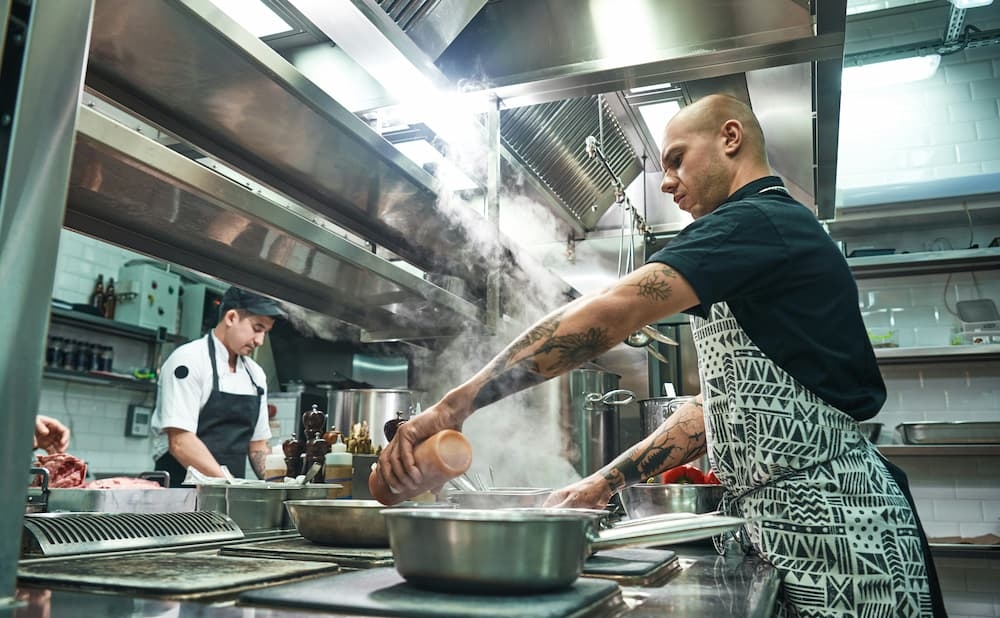Essential tips for safe and efficient food storage in your kitchen
Table of Contents
CloudKitchens
How many tacos can be delivered from a 1000sqft restaurant?
The same amount as a 200sqft ghost kitchen.
In any kitchen, but especially in high-volume environments like ghost kitchens and delivery-only restaurants, food storage plays a critical role in maintaining the safety, quality, and freshness of your products.
Proper food storage helps prevent foodborne illnesses, minimizes waste, and ensures the food you serve meets high safety standards. For ghost kitchens, which often lack a traditional storefront where customers can inspect food, the right storage practices are even more important to maintain customer trust and satisfaction.
By implementing safe food storage practices, you protect your customers, keep costs low, and ensure your food remains fresh for longer periods, resulting in higher profits and customer loyalty.
Whether you’re storing fresh produce, meat, dairy, or dry goods, understanding the key principles of food storage is essential to running an efficient and successful commercial kitchen!
Why is storing food important?
Storing food properly is essential for several reasons:
- Food safety: Proper storage prevents the growth of harmful bacteria and pathogens, ensuring your food is safe for consumption.
- Shelf-life extension: By keeping food at the right temperature and in the right conditions, you can extend its shelf life, reducing waste and maximizing profits.
- Cross-contamination prevention: Safe food storage helps prevent raw foods from contaminating cooked foods, which is crucial for keeping your kitchen hygienic and meeting health standards.
- Cost efficiency: Proper food storage helps reduce spoilage, which in turn reduces the need for constant restocking, saving money on wasted inventory.
What is the correct way to store food?
The correct way to store food involves several key practices that help maintain food safety, preserve freshness, and prevent contamination. Here are some of the most important principles:
Temperature control
- Cold foods: Perishable items such as dairy, meat, poultry, seafood, and certain fruits and vegetables need to be stored at low temperatures. The refrigerator should be set at or below 40°F (4°C), and the freezer should be at or below 0°F (-18°C).
- Hot foods: Hot foods should be kept at temperatures above 140°F (60°C) until they are served or delivered. This prevents bacterial growth and ensures the food remains safe.
Separation of raw and cooked foods
Raw foods, particularly meats, poultry, and seafood, should be stored separately from ready-to-eat foods to avoid cross-contamination. This is especially crucial in environments like ghost kitchens where food is being prepared and sent out quickly. Use separate storage containers or refrigerators for raw and cooked items.
Proper packaging
Proper packaging prevents air from reaching food and extends its shelf life. Foods should be sealed tightly in airtight containers, vacuum-sealed bags, or plastic wrap. This is particularly important for frozen foods. Clear, labeled packaging also helps kitchen staff easily identify items and track expiration dates.
FIFO (First In, First Out) system
The FIFO method ensures that older stock is used first. This reduces food spoilage and waste, as you’re always using the ingredients that are closest to their expiration date. Implementing FIFO helps ensure that you’re not discarding items that could have been used up in time.
Key food storage guidelines in an industrial kitchen
For industrial kitchens, especially those in ghost kitchens, specific guidelines need to be followed to maintain a safe and efficient food storage system:
Dry storage
Dry goods like flour, sugar, rice, and canned goods should be stored in a cool, dry place. They should be kept away from heat sources and humidity to prevent mold and spoilage. Shelving should be elevated to prevent contact with the floor and pests.
Cold storage (refrigerators and freezers)
Store perishable items such as meat, dairy, and produce in refrigerators at the appropriate temperatures. Ensure that refrigerators and freezers are well-maintained and equipped with accurate thermometers for temperature monitoring.
Items that need to be frozen, like meat or prepared foods, should be stored in deep freezers to maintain their quality for a longer period. Label and date frozen goods so they can be used in the correct order.
Labeling and dating
All food items should be clearly labeled with their contents and the date they were stored. This is especially important for perishable goods, as it helps staff track when items need to be used or discarded. It also helps reduce waste by allowing you to efficiently manage inventory.
Ventilation
Kitchens should be well-ventilated to maintain proper airflow and prevent the buildup of moisture, which can lead to mold and spoilage. Ensure that storage areas, especially for dry goods, have proper ventilation.
The basic rule of food storage
To summarize, the basic rule of food storage in an industrial kitchen can be broken down into three key principles:
- Keep it cold: Always store perishable foods at the correct temperature to prevent the growth of harmful bacteria.
- Keep it clean: Ensure your storage areas are kept clean and free of pests. Regularly sanitize refrigerators, freezers, and dry storage areas to maintain hygiene standards.
- Keep it separate: Raw foods should be stored away from cooked foods to prevent cross-contamination. Store raw meat, poultry, and seafood on the lowest shelves in the refrigerator to avoid drips onto other foods.
Read More: Innovative restaurant technology trends
How CloudKitchens helps with food storage in ghost kitchens
CloudKitchens understands the unique challenges faced by ghost kitchens and delivery-only restaurants. That’s why we offer temperature-controlled storage units and spacious facilities designed to optimize food storage.
Whether you need cold storage for perishables or dry storage for non-perishable goods, CloudKitchens provides an environment where you can store food safely and efficiently, ensuring quality and freshness for every order.
Our facilities are equipped with state-of-the-art kitchen technology and best practices to help you streamline operations, reduce food waste, and maximize productivity. With CloudKitchens, you can focus on what matters most: serving delicious meals to your customers while we help manage the logistical aspects.
Are you ready to optimize your kitchen’s operations and improve your food storage practices? Explore how CloudKitchens can help you run a safe, efficient, and profitable kitchen.
DISCLAIMER: This information is provided for general informational purposes only and the content does not constitute an endorsement. CloudKitchens does not warrant the accuracy or completeness of any information, text, images/graphics, links, or other content contained within the blog content. We recommend that you consult with financial, legal, and business professionals for advice specific to your situation.
Read more:
More insights & stories
There’s more where that came from.
Get in the know and check out our additional insights


